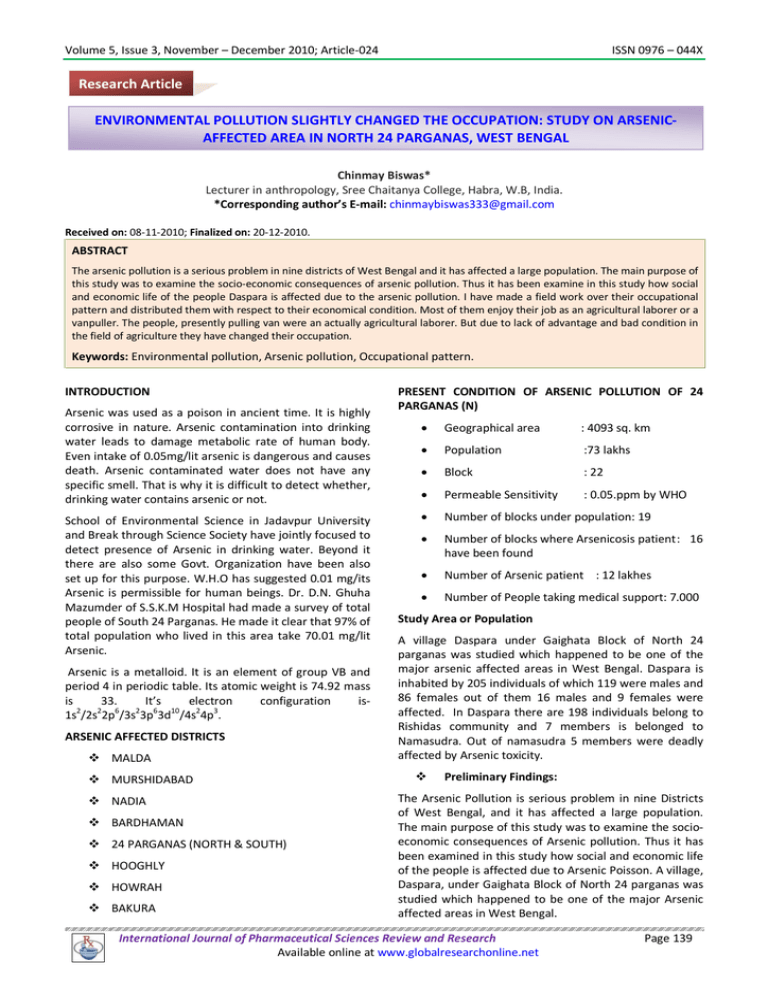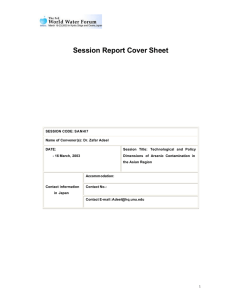Document 13308385
advertisement

Volume 5, Issue 3, November – December 2010; Article-024 ISSN 0976 – 044X Research Article ENVIRONMENTAL POLLUTION SLIGHTLY CHANGED THE OCCUPATION: STUDY ON ARSENICAFFECTED AREA IN NORTH 24 PARGANAS, WEST BENGAL Chinmay Biswas* Lecturer in anthropology, Sree Chaitanya College, Habra, W.B, India. *Corresponding author’s E-mail: chinmaybiswas333@gmail.com Received on: 08-11-2010; Finalized on: 20-12-2010. ABSTRACT The arsenic pollution is a serious problem in nine districts of West Bengal and it has affected a large population. The main purpose of this study was to examine the socio-economic consequences of arsenic pollution. Thus it has been examine in this study how social and economic life of the people Daspara is affected due to the arsenic pollution. I have made a field work over their occupational pattern and distributed them with respect to their economical condition. Most of them enjoy their job as an agricultural laborer or a vanpuller. The people, presently pulling van were an actually agricultural laborer. But due to lack of advantage and bad condition in the field of agriculture they have changed their occupation. Keywords: Environmental pollution, Arsenic pollution, Occupational pattern. INTRODUCTION Arsenic was used as a poison in ancient time. It is highly corrosive in nature. Arsenic contamination into drinking water leads to damage metabolic rate of human body. Even intake of 0.05mg/lit arsenic is dangerous and causes death. Arsenic contaminated water does not have any specific smell. That is why it is difficult to detect whether, drinking water contains arsenic or not. School of Environmental Science in Jadavpur University and Break through Science Society have jointly focused to detect presence of Arsenic in drinking water. Beyond it there are also some Govt. Organization have been also set up for this purpose. W.H.O has suggested 0.01 mg/its Arsenic is permissible for human beings. Dr. D.N. Ghuha Mazumder of S.S.K.M Hospital had made a survey of total people of South 24 Parganas. He made it clear that 97% of total population who lived in this area take 70.01 mg/lit Arsenic. Arsenic is a metalloid. It is an element of group VB and period 4 in periodic table. Its atomic weight is 74.92 mass is 33. It’s electron configuration is2 2 6 2 6 10 2 3 1s /2s 2p /3s 3p 3d /4s 4p . ARSENIC AFFECTED DISTRICTS MALDA MURSHIDABAD NADIA BARDHAMAN 24 PARGANAS (NORTH & SOUTH) HOOGHLY HOWRAH BAKURA PRESENT CONDITION OF ARSENIC POLLUTION OF 24 PARGANAS (N) Geographical area : 4093 sq. km Population :73 lakhs Block : 22 Permeable Sensitivity : 0.05.ppm by WHO Number of blocks under population: 19 Number of blocks where Arsenicosis patient : 16 have been found Number of Arsenic patient : 12 lakhes Number of People taking medical support: 7.000 Study Area or Population A village Daspara under Gaighata Block of North 24 parganas was studied which happened to be one of the major arsenic affected areas in West Bengal. Daspara is inhabited by 205 individuals of which 119 were males and 86 females out of them 16 males and 9 females were affected. In Daspara there are 198 individuals belong to Rishidas community and 7 members is belonged to Namasudra. Out of namasudra 5 members were deadly affected by Arsenic toxicity. Preliminary Findings: The Arsenic Pollution is serious problem in nine Districts of West Bengal, and it has affected a large population. The main purpose of this study was to examine the socioeconomic consequences of Arsenic pollution. Thus it has been examined in this study how social and economic life of the people is affected due to Arsenic Poisson. A village, Daspara, under Gaighata Block of North 24 parganas was studied which happened to be one of the major Arsenic affected areas in West Bengal. International Journal of Pharmaceutical Sciences Review and Research Available online at www.globalresearchonline.net Page 139 Volume 5, Issue 3, November – December 2010; Article-024 The study over their occupational pattern has been made and distributed with respect to their economical condition. Most of them enjoy their job as an agricultural labour or a Van-puller. Those who are pulling Van, now-adays were originally, agricultural labour because of several disadvantages in agricultural work. They were bound to change their occupation. It is observed that most of the agricultural labourer had denied cultivation as they were suffering from Arsenic Toxicity. In spite of giving up agricultural work, it has been detected that some of the Van-pullers still are suffering from Arsenicosis. The following observation concluded ISSN 0976 – 044X that as problem has not only been originated from agricultural laborer but also from other sources too. Due to Arsenic pollution most of the Arsenic Patients lost their efficiency to work hard denying their physical problem the persons those who can’t even pull Van due to insufficient ability still working in the field. Nine members of Agricultural labour are dangerously affected due to the Arsenic pollution & 4 members of Van-puller affected. The Van-pullers was actually agriculture labour. They desire to change their occupation due to the Toxicity. Table 1: Effects of Arsenic Toxicity Occupation Agricultural labourer Van-puller Student Housewife Without work Others Total No. Studied 37 17 58 40 46 7 205 No. Affected 9 4 8 2 2 25 % 4.39 1.95 0 3.90 0.98 0.98 12.20 CONCLUSION The Arsenic pollution is the serious problem in North 24 parganas, West Bengal & it has affected a large population. The study already was to examine the socioeconomic sequences of Arsenic pollution thus it has been examine in this study how social and economic life of the people is affected due to the Arsenic Poison. The study over there occupational patterns made it clear that the occupation of this villagers have slightly changed. Due to the Arsenic patients have lost their efficiency to work hard. The present study clearly indicates that inhabitants of Daspara are suffering from the toxic effect of Arsenic in this area, which in turn, is affecting their socio-economic status as well. REFERENCES 1. Chowdhury UK, Biswas BK, Chowdhury TR, Samanta G, Mandal BK, Basu GC, Chanda CR, Lodh D, Saha No. Unaffected 28 13 58 32 44 5 180 % 13.66 6.34 28.29 15.61 21.46 2.44 67.80 Total % 18.05 8.29 28.29 19.51 22.44 3.41 100.00 KC, Mukherjee SK, et al. (2000). Groundwater contamination in Bangladesh and West Bengal, India. Environ Health Perspect, 108:393-397. 2. Gupta SC, Kapoor VK. 1982. Fundamentals of Mathematical Statistic. New Delhi: Sultan Cahand and Sons. 3. Gilchrist W. 1984. Statistical Modelling. New York: Wiley, 1984. 4. World Health Organisation. Date. WHO guidelines nd for drinking water quality, recommendations (2 Edition) vol. 1. Geneva:WHO. 5. Current science, Vol-72. 6. Groundwater Arsenic calamity in Bangladesh (Current Science Vol-73) by scientists of SOES, DCH and NIPSOM. ************* International Journal of Pharmaceutical Sciences Review and Research Available online at www.globalresearchonline.net Page 140






